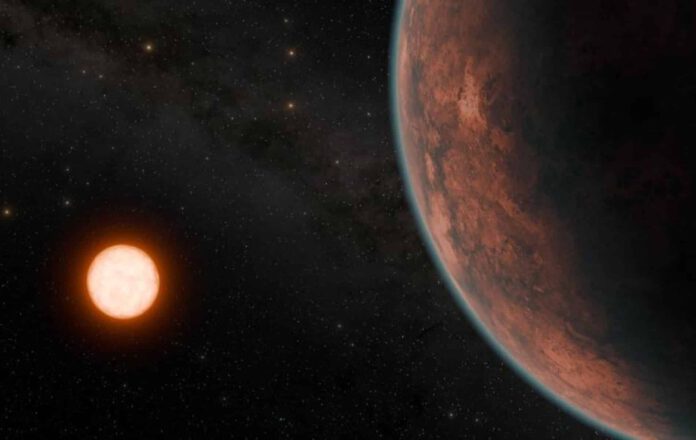
The planet has an estimated surface temperature of only 42 degrees Celsius and is located at approximately the same distance as the well-known TRAPPIST-1 system.
Astronomers’ Quest for Habitable Planets
For years, astronomers have been scouring the universe for planets that could potentially support life or at least be habitable, hoping to find worlds that resemble Earth. A new discovery has now generated significant excitement. Researchers have stumbled upon the promising planet Gliese 12 b, situated about 40 light-years away. Could this be the long-sought planet?
Gliese 12 b
The potentially habitable planet Gliese 12 b orbits its parent star every 12.8 days. In terms of size, this exoplanet is comparable to Venus, meaning it is only slightly smaller than Earth. Additionally, this Earth-like planet has a similar temperature to our home planet. The surface temperature is estimated at 42 degrees Celsius, making it slightly warmer than Earth but notably cooler than most of the approximately 5,000 exoplanets discovered to date. This discovery of the ‘exo-Venus’ was published today in the Monthly Notices of the Royal Astronomical Society.
Exo-Venus: A Glimpse into a New World
Researchers discovered Gliese 12 b using the planet-hunting telescope TESS, which has already illuminated numerous exoplanets. “We have identified the closest temperate world of Earth size so far,” emphasized researcher Masayuki Kuzuhara. “While we do not yet know if Gliese 12 b has an atmosphere, we consider it an ‘exo-Venus.’ It has a similar size and receives a comparable amount of energy from its star as our neighboring planet in our own solar system.”
The Importance of an Atmosphere
To determine if the planet is habitable, it is crucial to establish whether it has an atmosphere. The planet might possess an atmosphere similar to Earth’s, or it could resemble Venus, where a substantial greenhouse effect has led to surface temperatures of around 400 degrees Celsius. Another possibility is that it has no atmosphere at all or an entirely different kind of atmosphere not seen in our solar system. Understanding this is vital as it will indicate whether Gliese 12 b can maintain temperatures suitable for liquid water—and potentially life—on its surface.
The Parent Star’s Influence
The parent star of Gliese 12 b is a cool red dwarf star named Gliese 12, located almost 40 light-years from Earth in the constellation Pisces. The star is approximately 27 percent the size of our sun and has a surface temperature about 60 percent that of our sun. Red dwarf stars are known to be magnetically active and prone to frequent, intense flares that can strip nearby planets of their atmospheres. However, Gliese 12 b appears to fare better, as analyses have shown that Gliese 12 does not display such extreme behavior. This raises hopes that the potential atmosphere of Gliese 12 b remains intact.
Surface Temperature and Habitability
The distance between Gliese 12 and the newly discovered planet is only 7 percent of the distance between Earth and the sun. Consequently, Gliese 12 b receives 1.6 times more energy from its star than Earth does from the sun, and about 85 percent of the energy that Venus receives. This difference in solar radiation is crucial because it indicates that the planet’s surface temperature is significantly influenced by atmospheric conditions. The estimated surface temperature of Gliese 12 b is 42 degrees Celsius, while Earth’s average surface temperature is 15 degrees Celsius. “Atmospheres trap heat and can significantly impact the actual surface temperature, depending on their composition,” explains researcher Shishir Dholakia.
Implications for Earth and Venus
The research into Gliese 12 b extends beyond the planet’s habitability. It also helps us understand why Earth and Venus—planets that are similar in many ways—have taken such different paths. “Since Gliese 12 b receives a comparable amount of light as Earth and Venus from the sun, it can help us explain and understand the differences between these two planets in our own solar system,” Dholakia adds. This can provide valuable insights into the atmospheric processes that influence planetary habitability. While Earth is habitable, Venus is not, primarily due to the complete loss of water. “Gliese 12 b, with a temperature between that of Earth and Venus, can help us understand how planets become habitable, especially by examining its atmosphere,” says co-author Larissa Palethorpe.
Research into the promising exo-Venus continues unabated. The idea that this planet may be habitable captivates many astronomers’ imaginations. While Gliese 12 b is certainly not the first Earth-like exoplanet discovered, NASA believes only a few such worlds are worth further investigation. The next step is to target the powerful James Webb Space Telescope at Gliese 12 b. Ultimately, researchers hope to determine whether this planet does indeed have an atmosphere. “Gliese 12 b represents one of the best targets to study whether Earth-like planets orbiting cool stars can retain their atmospheres,” says Dholakia. “This is a crucial step to advancing our understanding of the habitability of planets in our galaxy.”











